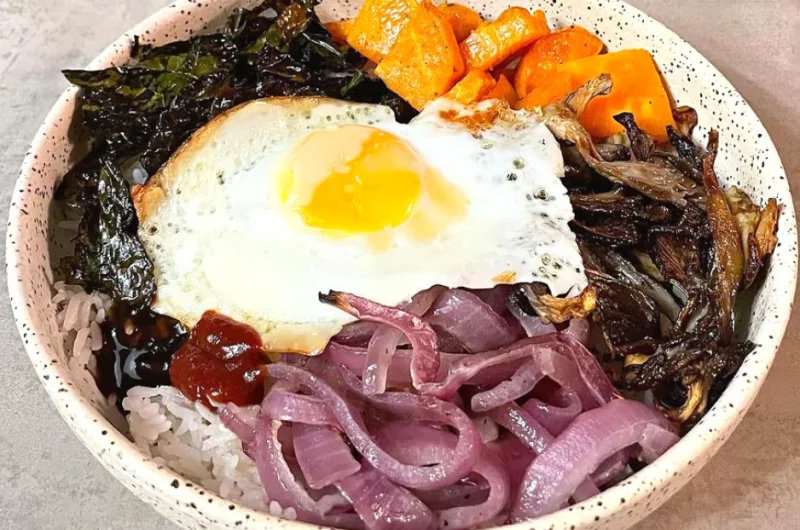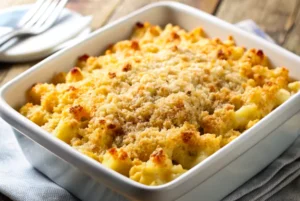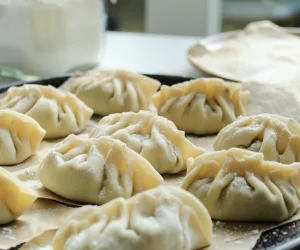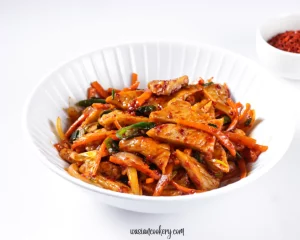Sheet Pan Bibimbap it’s my absolute favorite One! I got the idea from Eric Kim, and it’s a clever and easy version of the classic Korean dish Bibimbap. You toss all the yummy stuff like oyster mushrooms and sweet potatoes on one tray, making it a breeze to cook.

The best part? Just mix everything up before you dig in! “Bibimbap” means “mixed rice” in Korean, and this recipe keeps things simple while packing in loads of flavor. I’m telling you, this dish is not just easy; it’s like a flavor explosion that I can’t get enough of. Give Sheet Pan Bibimbap a shot—it’s my kitchen superstar, and I bet you’ll love it too!
What is Bibimbap?
Bibimbap, called “비빔밥” in Korean, is a tasty dish from Korea. It’s like a bowl of warm rice with veggies, meat (usually beef), and a fried or poached egg on top. They add a spicy sauce called gochujang to make it flavorful. The fun part is mixing everything together before eating. So, it’s not just a yummy meal; it’s also a cool way to enjoy different flavors all at once!
How to make Sheet Pan Bibimbap

Kitchen Equipment to make Sheet Pan Bibimbap
- Small baking sheet
- Oven
- Spatula
- Mixing bowls
- Chopsticks or spoon
Ingredients:
- 6 ounces oyster mushrooms, torn into bite-size pieces
- 1 medium sweet potato (about 6 ounces), scrubbed and thinly sliced into half-moons
- 1 small red onion (about 6 ounces), thinly sliced crosswise into half-moons
- 3 packed cups coarsely chopped Tuscan or curly kale (from 1 small bunch)
- 6 tablespoons olive oil
- Kosher salt and black pepper
- 2 cups cooked medium-grain white rice, preferably cold leftovers
- 2 large eggs
- 2 teaspoons toasted sesame oil, plus more to taste, for serving
- 2 teaspoons gochujang, plus more to taste, for serving
Instructions:
Step 1:
Preheat the Oven Start by preheating your oven to 450 degrees. Make sure to position the oven racks in the top and bottom thirds for the best cooking results.
Step 2:
Prepare the Vegetables On a small baking sheet, arrange the oyster mushrooms, sweet potatoes, red onions, and kale in separate sections. Drizzle 3 tablespoons of olive oil over them, sprinkle with salt and pepper, and gently toss to coat. Roast on the top rack for about 20 to 25 minutes, or until the sweet potatoes are tender, and the mushrooms, onions, and kale are nicely caramelized and crispy.
Step 3:
Cook the Rice and Eggs While the veggies are roasting, get another small baking sheet ready on the bottom rack. In the last 5 minutes of veggie cooking time, take out the heated pan, drizzle the remaining 3 tablespoons of olive oil, spread the rice on one side, and crack the eggs on the other. Put it back in the oven and bake until the egg whites are set and the yolks are still a bit runny, which usually takes about 3 to 6 minutes.
Step 4:
Plate and Add Flavor To serve, divide the rice between two bowls. Arrange the roasted veggies on top of each portion, gently placing the eggs over them. Drizzle each bowl with 1 teaspoon of sesame oil and add a dollop of gochujang, adjusting to your taste preference. Mix everything with chopsticks or a spoon, ensuring each bite captures the essence of this delicious dish. Enjoy!
Tips for Perfect Sheet Pan Bibimbap:
- Veggie Variety: Feel free to get creative with your veggies. Try adding bell peppers, zucchini, or bean sprouts to the mix. This recipe is versatile, so use your favorite vegetables or whatever you have on hand.
- Prep Ahead: Save time by prepping some ingredients in advance. Chop the vegetables or marinate them in olive oil, salt, and pepper a few hours before cooking. This way, you can quickly assemble everything when it’s time to cook.
- Egg-cellent Timing: If you prefer well-cooked eggs, leave them in the oven for a little longer. For a runnier yolk, reduce the baking time. Keep an eye on them during the last few minutes to achieve your desired level of doneness.
How to Store
To store Sheet Pan Bibimbap leftovers, put them in sealed containers in the fridge. It’s best to keep the rice and veggies separate from the sauce and eggs. Eggs might lose their runny texture after refrigeration, so be ready for that. When reheating, use short intervals in the microwave, and add a bit of water to the rice to keep it moist. This way, you can enjoy your Bibimbap for round two without losing any flavor!
FAQ
Can I use different vegetables in this recipe?
Absolutely! Feel free to experiment with your favorite veggies or use what’s available. Bell peppers, zucchini, or bean sprouts make great additions.
How do I keep the eggs runny when reheating leftovers?
Reheating eggs can change their texture, but you can try briefly warming them separately before serving or adding a freshly cooked egg when reheating.
Can I prepare some ingredients in advance?
Yes! Save time by chopping veggies or marinating them a few hours before cooking. This makes assembling the dish quicker when you’re ready to cook.
Is it okay to use brown rice instead of white rice?
Absolutely! Brown rice is a nutritious alternative with a nuttier flavor. Feel free to swap it out based on your preference.
Can I freeze Sheet Pan Bibimbap?
A: It’s best to avoid freezing this dish, as the veggies and eggs may not retain their original texture after thawing. Enjoy it fresh or refrigerate leftovers for the best taste and texture.
Sheet Pan Bibimbap
Course: MainCuisine: Korean FusionDifficulty: Medium2
servings15
minutes25
minutes40
minutesSheet Pan Bibimbap it’s my absolute favorite One!
Ingredients
6 ounces oyster mushrooms, torn into bite-size pieces
1 medium sweet potato (about 6 ounces), scrubbed and thinly sliced into half-moons
1 small red onion (about 6 ounces), thinly sliced crosswise into half-moons
3 packed cups coarsely chopped Tuscan or curly kale (from 1 small bunch)
6 tablespoons olive oil
Kosher salt and black pepper
2 cups cooked medium-grain white rice, preferably cold leftovers
2 large eggs
2 teaspoons toasted sesame oil, plus more to taste, for serving
2 teaspoons gochujang, plus more to taste, for serving
Directions
- Preheat the Oven Start by preheating your oven to 450 degrees. Make sure to position the oven racks in the top and bottom thirds for the best cooking results.
- Prepare the Vegetables On a small baking sheet, arrange the oyster mushrooms, sweet potatoes, red onions, and kale in separate sections. Drizzle 3 tablespoons of olive oil over them, sprinkle with salt and pepper, and gently toss to coat. Roast on the top rack for about 20 to 25 minutes, or until the sweet potatoes are tender, and the mushrooms, onions, and kale are nicely caramelized and crispy.
- Cook the Rice and Eggs While the veggies are roasting, get another small baking sheet ready on the bottom rack. In the last 5 minutes of veggie cooking time, take out the heated pan, drizzle the remaining 3 tablespoons of olive oil, spread the rice on one side, and crack the eggs on the other. Put it back in the oven and bake until the egg whites are set and the yolks are still a bit runny, which usually takes about 3 to 6 minutes.
- Plate and Add Flavor To serve, divide the rice between two bowls. Arrange the roasted veggies on top of each portion, gently placing the eggs over them. Drizzle each bowl with 1 teaspoon of sesame oil and add a dollop of gochujang, adjusting to your taste preference. Mix everything with chopsticks or a spoon, ensuring each bite captures the essence of this delicious dish. Enjoy!
Notes
- Veggie Variety: Feel free to get creative with your veggies. Try adding bell peppers, zucchini, or bean sprouts to the mix. This recipe is versatile, so use your favorite vegetables or whatever you have on hand.
- Prep Ahead: Save time by prepping some ingredients in advance. Chop the vegetables or marinate them in olive oil, salt, and pepper a few hours before cooking. This way, you can quickly assemble everything when it’s time to cook.
- Egg-cellent Timing: If you prefer well-cooked eggs, leave them in the oven for a little longer. For a runnier yolk, reduce the baking time. Keep an eye on them during the last few minutes to achieve your desired level of doneness.





